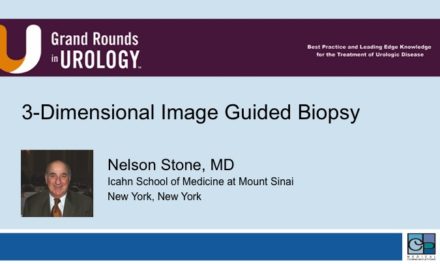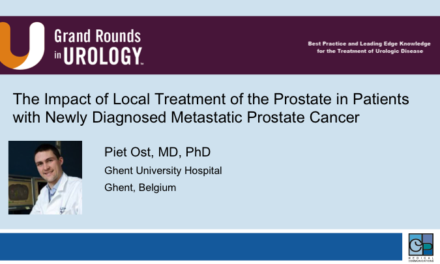
PCa Commentary | Volume 191 – July 2024
Posted by Edward Weber | July 2024
Radioligand Therapy (RLT): 177Lu-PSMA-617: Pluvicto Update and Introducing 225-Actinium-617 RLT
A comprehensive discussion of RLT was presented by Viscuse et al., J Nucl Med 2024: “Clinical Management of Advanced Prostate Cancer: Where Does Radiopharmaceutical Therapy Fit in the Treatment Algorithm?” — the subject for this Commentary.
The Vision Trial of Pluvicto established the effectiveness and safety of 177Lu-PSMA-617 in therapy of heavily pre-treated men with advanced prostate cancer. The trial compared Pluvicto plus standard of care vs SOC only (excluding chemotherapy, immunotherapy or Radium-223). At 20.9 months of follow-up the median progression-free survival (mPFS) was 8.7 vs 3.4 months and median overall survival (mOS) – 15.3 vs 11.3 months, respectively. In this group of men with advanced cancer treated with Pluvicto 46% had a > 50% drop in PSA and 33% had a > 80% decline compared to those on SOC showing 7.1% and 2% declines. However, with Pluvicto 28% of men showed no PSA decline and 10% had progressive disease.
Limitations to responding to 177Lu therapy have become apparent. The heterogeneity of PSMA expression on prostate cancer cells presents a challenge to Pluvcto’s overall effectiveness. As reported in Viscuse, “Up to 15% – 20% of prostate cancers lose PSMA expression” … and “PSMA expression has been noted to vary across sites of metastases even in patients with PSMA-positive mCRPC.” Response to 177Lu is less effective in lesions with low PSMA intensity as expressed in SUV values. The SUV (standardized uptake value) compares the relative uptake at a metastatic site to that in the liver. Intense uptake might be 20 – 30 SUVs or more. Eligibility for the Thera P trial of 177Lu required all lesions to have SUV values of >10.
Common adverse effects of Pluvicto include bone marrow suppression, fatigue, arthralgias, nausea and loss of appetite. Dry month is especially troublesome due to cellular injury from 177Lu uptake in the PSMA expressing salivary and lacrimal glands. Dry month has been found very difficult to prevent or ameliorate, despite external cooling, salivary duct dilation and corticosteroid injections into the glands.
Moving 177Lu Earlier in the Treatment Schema:
Data presented at 2024 Society of Nuclear Medicine and Molecular Imaging (SNMMI) Annual Meeting (Abstract 241064) by Ken Herrman, MD. (Voted Best Abstract of the Year) is summarized below.
The Vision trial required that all men were required to have had chemotherapy (with some exceptions) prior to receiving 177Lu-PSMA-617 (Pluvicto). The recently reported PSMAfore trial omitted that requirement. It enlisted men with mCRPC who had experienced “progression on prior androgen-receptor pathway inhibitor therapy,” either Xtandi or Zytiga. Upon failing one of these drugs the 468 men were randomized between Pluvicto or the alternative androgen receptor signaling inhibitor (ARSi). Pluvicto was administered at 6-week intervals for 6 cycles.
No chemotherapy intervened. Staging was evaluated with a 68Ga-PSMA-11 PET scan and eligibility required no PSMA-negative lesions. Crossover was allowed at failure of either regimen.
Findings:
- Radiographic progression-free survival was 9.3 months vs 5.55 for the ARSi.
- Objective radiographic response: 50.7% for 177Lu vs 14.9% ARSi.
- >50% decline in PSA: 177Lu 57.6% vs 20.4% ARSi.
- 177Lu showed a “Longer median time to PSA progression, 10.55 months vs 4.24 months.”
Oliver Sartor, MD, Director of Radiopharmaceutical Trials, Mayo Clinic, felt that these results “have the potential to change the treatment paradigm for patients with advanced prostate cancer in the pretaxane setting” and, if approved by the FDA “will be incorporated into the updated product describing information, providing easier access to this therapy.”
Way Up-Front Pluvicto: Initial Therapy for Oligometastatic Hormone-Sensitive Prostate Cancer
Pluvicto has been tested in a small study as a single up-front agent in men with omHSPC (oligometastatic hormone-sensitive PC with < 10 metastatic lesions and PSA doubling time
<6 months. The question was whether Pluvicto can be an alternative to ADT. Five of 10 patients had a >50% reduction in PSA, raising the issue of combining 177Lu with ADT as incorporated in the ENZA-p trial joining 177Lu with Xtandi, or the trial combining 177Lu with olaparib (Lynparza).
[225Actinium]-Ac-PSMA-617:
225Ac-PSMA-617 is an alpha-emitting radionuclide in an advanced state of development. 177Lu and 225Ac both utilize the same targeting peptide, PSMA-617, (peptide: a short chain of amino acids) and target an extracellular epitope on the cancer cell’s surface PSMA biomarker. After attachment 225Ac is internalized, emitting four alpha particles (nuclei of helium atoms) in sequential decay over a half-life of ~10 days. Unlike the beta emissions of 177Lu, which emit fast moving and far-reaching electrons, the heavy alpha particles travel only one or two cell widths (40-100 millimicrons) delivering high linear energy transfer causing clusters of lethal double-stranded DNA breaks. The limited range of the alpha particles reduce damage to normal tissue surrounding the cancer, such as bone marrow.
RLT with 225Ac-PSMA-617 is an active area of clinical research in men with mCRPC and has already shown impressive results and safety. The most recent and extensive trial was reported by Sathekge et al. in The Lancet, Jan. 2024. It was an international study of 448 men with mCRPC (median baseline PSA,169 ng/mL), heavily pre-treated with ADT, ARSi, 177Lu and Radium-223. The median OS of all patients was 15.5 months, with mOS of 24 months in men whose PSA dropped >50%; mPFS was 7.9 months. In men with a >50% PSA decline the mPFS was
11 months. Dry mouth developed in ~68% or more men after the first cycle of treatment. Significant anemia occurred in 13% of men, decreased white blood cells in 4% and decreased platelets in 7%.
The efficacy and safety of 225Ac-PSMA-617 was studied in 106 men with extensive skeletal metastases by Lawal et al.,Eur j Nucl Med Imaging, 2022. All men had >20 metastatic sites and had a median of 4 treatment cycles. 80% showed a PSA response. Median PFS was 14 months and mOS, 15 months. Severe bone marrow suppression was infrequent — seen in only < 2.8%.
225Ac and 177Lu both address the PSMA target but with different intensities. Stangl-Kremser et al., Prostate. 2023, reported on the response of 225Ac treatment after prior 177Lu therapy. Based on data from 212 men with mCRPC the mPFS for men treated with 225Ac after first receiving 177Lu was 4.3 months. For those men treated with 177Lu only the mPFS was 14.3 months.
Since both 225Ac and 177Lu attack the PSMA target and ~ 15+% of men lack PSMA expression, neither drugs will result in a response to PSMA directed therapy. An alternative target is needed. CD46 is another surface protein highly expressed on prostate cancer cells. Researchers at UCSF are developing an antibody-drug conjugate directed at CD46. (Bidder et al, Clint Cancer Research. 2023.)
BOTTOM LINE:
Radioligand therapy is a rapidly advancing new treatment category with 177Lu-PSMA-617 (Pluvicto) already in current use. 225Ac-PSMA-617 is under development. Research is ongoing to place these agents earlier in the treatment schema of mCRPC as single agents and in combinations.
Your comments and requests for information on a specific topic are welcome e-mail ecweber@nwlink.com.
Please also visit https://prostatecancerfree.org/prostate-cancer-news for a selection of past issues of the PCa Commentary covering a variety of topics.
“We appreciate the unfailing assistance of the librarians at Providence/Swedish.”
ABOUT THE AUTHOR
Edward Weber, MD, is a retired medical oncologist living in Seattle, Washington. He was born and raised in a suburb of Reading, Pennsylvania. After graduating from Princeton University in 1956 with a BA in History, Dr. Weber attended medical school at the University of Pennsylvania. His internship training took place at the University of Vermont in Burlington.
A tour of service as a Naval Flight Surgeon positioned him on Whidbey Island, Washington, and this introduction to the Pacific Northwest ultimately proved irresistible. Following naval service, he received postgraduate training in internal medicine in Philadelphia at the Pennsylvania Hospital and then pursued a fellowship in hematology and oncology at the University of Washington.
His career in medical oncology was at the Tumor Institute of the Swedish Hospital in Seattle where his practice focused largely on the treatment of patients experiencing lung, breast, colon, and genitourinary cancer and malignant lymphoma.
Toward the end of his career, he developed a particular concentration on the treatment of prostate cancer. Since retirement in 2002, he has authored the PCa Commentary, published by the Prostate Cancer Treatment Research Foundation, an analysis of new developments in the prostate cancer field with essays discussing and evaluating treatment management options in this disease. He is a regular speaker at various prostate cancer support groups around Seattle.




